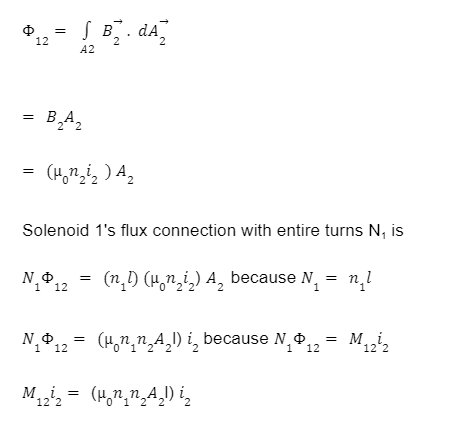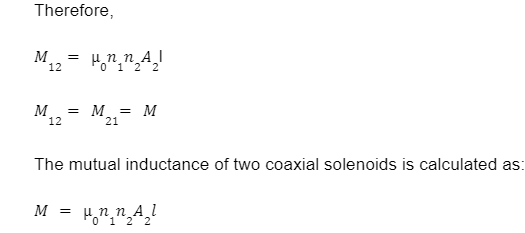Mutual inductance refers to the property of two coils in which each resists any change in the value of current passing through the other by generating an induced emf and Henry is the SI unit for mutual inductance. A solenoid is a device that controls the flow of electricity. It is a kind of electromagnet that creates a regulated magnetic field and is made out of a helix coil of wire with a length significantly longer than its diameter. Read on further to calculate the mutual inductance of two coaxial solenoids.
Mutual Inductance
The mutual inductance of coils is described as the emf caused by magnetism in one coil opposing current and voltage changes in the other coil. Because of the shift in magnetic flux, the coils are magnetically connected. The magnetic field of one coil interacts with the magnetic field of another coil.
Because of the shift in magnetic flux, the current that flows in one coil causes the voltage in another coil to rise. The mutual inductance & change in current are accurately proportional to the quantity of magnetic field coupled to the two coils.
Coaxial Solenoid
A solenoid is a device that controls the flow of electricity. It is a kind of electromagnet that creates a regulated magnetic field and is made out of a helix coil of wire with a length significantly longer than its diameter. Whenever an electric current is fed through the coil, it may generate a homogenous magnetic flux in a volume of space. André-Marie Ampère created the word solenoid in 1823.
A solenoid’s helical coil does not have to circle on a straight axis; for instance, William Sturgeon’s electromagnet used a solenoid twisted into a horseshoe form.
Solenoids are used in television camera tubes like vidicons or image orthicon to offer magnetic focussing of electrons in vacuums. Inside the magnetic field, electrons follow helical trajectories. These solenoids encircle nearly the entire length of the tube.
Mutual Inductance Of Two Coaxial Solenoids
Consider two coaxial solenoids with the same length l. Because the length of these solenoids is greater than their radii, the magnetic field generated inside them is homogenous, and the fringing effect towards the ends may be ignored. Let A1 & A2 become the area of cross-section of the solenoids, with A1 being bigger than A2. These solenoids have n1 & n2 turn density, respectively.
If i1 is the current that flows into solenoid 1, the magnetic field generated within it is
The magnetic flux is connected for each round of solenoid 2 owing to solenoid 1 as the field lines of 1 travel through the area enclosed by solenoid 2 and is given by:

This yields the formula for the solenoid 2’s mutual inductance M21 in relation to solenoid 1. Similarly, the mutual inductance M21 of solenoid 1 and solenoid 2 may be found as shown below.
When conducting a current i2, the solenoid 2 produces a magnetic field.
Inside the solenoid 2, the magnetic field B2 is uniform, when outside the solenoid 2, it is nearly zero. As a result, for solenoid 1, the effective area on which the magnetic flux B2 exists is A2, not A1. The magnetic flux 12 due to solenoid 2 is thus coupled with every turn of solenoid 1.


Conclusion
The mutual inductance of coils is described as the emf caused by magnetism in one coil opposing current and voltage changes in the other coil. Because of the shift in magnetic flux, the coils are magnetically connected together. A solenoid is a device that controls the flow of electricity. It is a kind of electromagnet that creates a regulated magnetic field and is made out of a helix coil of wire with a length significantly longer than its diameter. The mutual inductance of two co-axial solenoids is calculated as: M = 0n1n2A2l. Read the above article thoroughly for understanding how the formula is derived.
 Profile
Profile Settings
Settings Refer your friends
Refer your friends Sign out
Sign out













